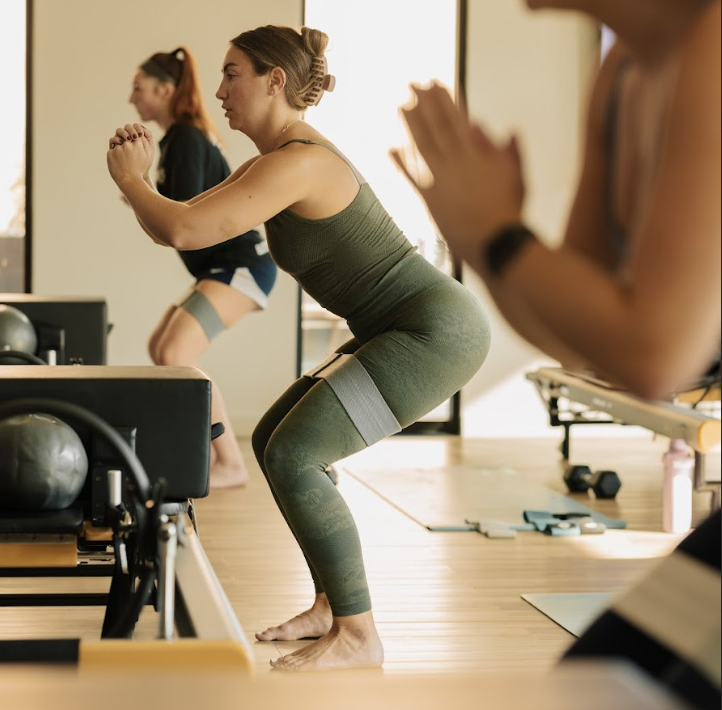
What Does FS8 Stand For? Our 8 Training Pillars Explained
Whether you’re a gym veteran, workout newbie, or returning to regular exercise after an injury, FS8 classes are designed to meet everyone’s needs. Classes run every day of the week and combine a mix of pilates, tone, and yoga movements that can be adjusted to suit individual skill level and desired intensity.
These are some of the reasons why FS8 is popular with so many people, but you might still be wondering, “what does FS8 stand for?” So here it is: the first two letters refer to functional style training, which guides all our workouts. The 8 is in reference to each of the elements of fitness we use to build classes – read on to discover what they are and why we champion them.

What is FS8? A guide our 8 elements of fitness
When it comes to the question of ‘what is FS8 training?’ It’s best understood through the training elements we use to construct each training session. These pillars were created to ensure you can get the most out of all our FS8 workouts – so what are they?
- Cardio
- Mobility
- Posture
- Coordination
- Resistance
- Mental health
- Balance
- Flexibility
Next we’ll unpack each element in depth to help you understand what to expect from FS8.
Cardio
When it comes to exercise that provides benefits for the whole body, many people consider cardio to be king. Rhythmic aerobic exercises stimulate the heart, lungs and muscles as they work together to raise your heart rate.
During FS8 Blast classes, cardiovascular focused movements can improve endurance, raise oxygen levels and support blood flow – but the benefits don’t end when you leave the session. Our workouts aim to improve your daily life by supporting things like sleep quality and reduced stress levels.
Mobility
A guiding principle of functional strength training is movements that mimic how we move in life outside of the gym to improve body function in day-to-day tasks. Mobility is an element of fitness that can uplift physical longevity and reduce risk of injury both in and out of the gym.
FS8 workouts focus on mobility with exercises that require active movement through a full range of motion, which can prevent injury by improving muscle control around each joint.
Posture
Correct posture and alignment play an important role in a whole host of essential bodily functions like blood flow, digestion, and breathing. Beyond these vital functions, better posture can result in more effective workouts with better form and can help reduce headaches and muscle pain. So, what is FS8 training for posture? Our FS8 Restore classes aim to improve posture through slow flow yoga and pilates movements that require good form and proper alignment.
Coordination
Coordination requires balance and agility, so supporting it can provide the double benefit of enhancing workouts and making daily tasks easier. Elements of fitness like coordination can help you cultivate the mind body connection, so the different styles of exercise used in FS8 Remix can be ideal. These classes combine several movements in one fluid motion, engaging the brain to concentrate on initiating coordinated and controlled movement while maintaining correct form.
Resistance
Resistance based exercises are one of the key elements of fitness used to build strength and tone, anaerobic contraction, and lean muscle mass. FS8 OG classes can increase muscle contraction by focussing on resistance through body weighted exercise, free weights, spring tensions and training bands. Because this kind of exercise requires controlled movement through each action, it has additional benefits likes improving flexibility and balance.
Mental health
The mental health benefits of physical exercise and social activity are well documented, and the two make a powerful pairing at FS8. Group training classes promote social connection and encourage relationship building by bringing people together, which can reduce feelings of loneliness and isolation.
While physical exercise triggers the release of feel-good hormones like endorphins and serotonin that can boost mood, concentration, alertness and even self-esteem.
Balance
Balance training is an important consideration as an element of fitness for increasing core strength, flexibility, and endurance. Beyond contributing to your overall fitness, good balance is necessary for everyday movements like standing and walking and plays a significant role in functions like cognition and vision. In terms of how to improve balance through exercise, movements that require stability can be ideal, like yoga or pilates.
Flexibility
Flexibility is the ability to move muscles and joints through a full range of motion freely. Enhancing flexibility can have knock on effects like increasing athletic performance and muscle length, improving posture and balance, and promoting efficient movement.
Flexibility is all about working on the muscles’ ability to contract and expand, so it’s an element of fitness that can both support active recovery and reduce risk of muscle related injury in the first place.

